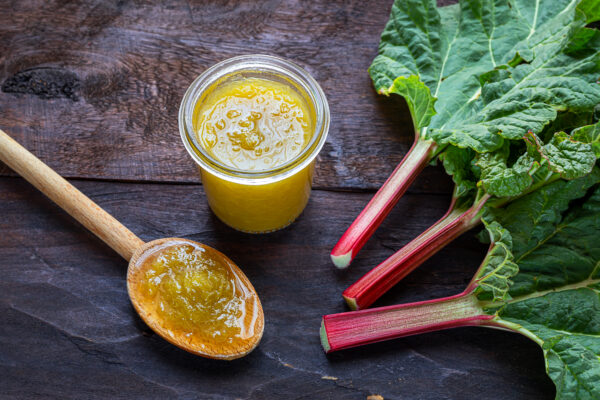Hello there! Have you ever wondered if you can freeze rhubarb without cooking it first? In this article, we’ll explore the possibility of freezing rhubarb without any cooking involved. You’ll learn about the benefits of freezing rhubarb, the steps to freeze it properly, and some handy tips to ensure the best results. So, if you’re interested in preserving your rhubarb for future use, keep reading!

Can You Freeze Rhubarb Without Cooking It
Rhubarb is a versatile and delicious vegetable that is used in a variety of sweet and savory dishes. Whether you have a surplus of fresh rhubarb from your garden or have found a great deal at the grocery store, you may be wondering if you can freeze rhubarb without cooking it. The good news is, yes, you can freeze rhubarb without cooking it! Freezing rhubarb is a simple and effective way to preserve its freshness and flavor for later use. In this article, we will explore the basics of freezing rhubarb, the methods and steps involved, as well as tips and tricks for successful freezing and using frozen rhubarb. So let’s get started!
Why Freeze Rhubarb?
Freezing rhubarb is a great way to extend its shelf life and enjoy its unique flavor throughout the year. Fresh rhubarb is typically in season in the spring and early summer, so freezing allows you to enjoy rhubarb’s tangy taste even during the off-season. Freezing rhubarb also helps to preserve its nutritional value, as freezing locks in the vitamins and minerals contained in the vegetable. Additionally, freezing rhubarb is a convenient way to have this versatile ingredient readily available for baking pies, making jams, or adding to smoothies or savory dishes at any time.
Methods of Freezing Rhubarb
There are two primary methods of freezing rhubarb: freezing it raw or blanching it before freezing. Freezing rhubarb raw is the simplest method and requires minimal preparation. Blanching, on the other hand, involves briefly boiling the rhubarb before freezing to help preserve its color and texture. Both methods are effective in preserving the flavor and quality of rhubarb, so the choice ultimately depends on personal preference and intended use.
Freezing Rhubarb Without Cooking It
Benefits of Freezing Raw Rhubarb
Freezing raw rhubarb has several benefits. Firstly, it requires minimal preparation, making it a quick and easy method. It also helps to retain the natural crunch and texture of the rhubarb stalks, which can be desirable in certain recipes. Freezing raw rhubarb also allows for greater versatility in its use since it can be thawed and used in both cooked and uncooked dishes.
Step-by-Step Guide to Freezing Raw Rhubarb
Here is a step-by-step guide to freezing raw rhubarb without cooking it:
- Start by selecting fresh rhubarb stalks. Look for stalks that are firm, crisp, and free from blemishes or signs of decay.
- Wash the rhubarb stalks thoroughly under cold running water to remove any dirt or impurities.
- Trim off the ends of the stalks and discard any leaves, as they are toxic and should not be eaten.
- Cut the rhubarb stalks into desired lengths or slices. It is recommended to cut them into pieces that are about 1-inch long for easier handling and portioning later.
- Arrange the rhubarb pieces in a single layer on a baking sheet lined with parchment paper or a silicone mat. Make sure the pieces are not touching each other to prevent them from sticking together during freezing.
- Place the baking sheet with the rhubarb pieces in the freezer and let them freeze for about 1 to 2 hours, or until they are firm to the touch.
- Once the rhubarb pieces are frozen, transfer them into airtight freezer bags or containers. Remove any excess air from the bags or containers before sealing them tightly.
- Label the bags or containers with the date of freezing and place them back in the freezer for long-term storage.
By following these simple steps, you can easily freeze raw rhubarb without cooking it and have it ready to use whenever you need it.

Preparing Rhubarb for Freezing
Selecting Fresh Rhubarb
When it comes to freezing rhubarb, selecting fresh and high-quality stalks is crucial. Look for rhubarb stalks that are firm, crisp, and bright in color. Avoid rhubarb with blemishes, soft spots, or signs of decay, as these can indicate poor quality or spoilage. It is also best to choose rhubarb with thinner stalks, as they tend to be more tender and flavorful.
Cleaning and Trimming Rhubarb Stalks
Before freezing rhubarb, it is important to clean and trim the stalks properly. Start by washing the stalks under cold running water to remove any dirt or debris. Gently scrub the stalks with your hands or a soft brush to ensure thorough cleaning. After washing, trim off the ends of the stalks and discard them. It is also essential to remove the leaves of the rhubarb, as they are toxic and should never be consumed. Rhubarb leaves contain high levels of oxalic acid, which can be harmful if ingested.
Packaging and Storing Frozen Rhubarb
Choosing the Right Packaging
Proper packaging is crucial for preserving the freshness and quality of frozen rhubarb. When choosing packaging for freezing rhubarb, opt for airtight freezer bags or containers that are specifically designed for freezing. These packaging materials help to protect the rhubarb from freezer burn and prevent unwanted odors from affecting its flavor. It is recommended to divide the rhubarb into smaller portions before packaging, as this allows for more flexibility when thawing and using the frozen rhubarb later.
Proper Storage Conditions
To ensure the best quality and flavor, it is important to store frozen rhubarb in the right conditions. Always place the packaged rhubarb in the coldest part of your freezer, such as the back or bottom shelf. This helps to maintain a consistent and optimal freezing temperature. It is also important to keep the freezer temperature at 0°F (-18°C) or below to prevent any potential spoilage or loss of quality.
Using Frozen Rhubarb
Thawing Frozen Rhubarb
When it comes to using frozen rhubarb, proper thawing is essential to maintain its texture and flavor. The best way to thaw frozen rhubarb is to transfer it from the freezer to the refrigerator and let it thaw slowly overnight. This gradual thawing process helps to preserve the rhubarb’s texture and prevent any excess moisture. Once thawed, it is important to use the rhubarb within 24 to 48 hours to ensure maximum freshness.
Cooking with Thawed Rhubarb
Thawed rhubarb can be used in a variety of recipes, both sweet and savory. It is important to note that thawed rhubarb tends to release more liquid than fresh rhubarb, so you may need to adjust the liquid content in your recipes accordingly. Thawed rhubarb is perfect for making pies, tarts, crumbles, jams, sauces, or adding to muffins, cakes, and other baked goods. It can also be used in savory dishes like chutneys, relishes, or as an accompaniment to meats or poultry.
Tips and Tricks for Freezing Rhubarb
Blanching Rhubarb
Blanching rhubarb before freezing is an alternative method that can help preserve its color and texture. To blanch rhubarb, simply bring a pot of water to a boil and drop the rhubarb pieces into the boiling water for about 1 to 2 minutes. Quickly transfer the blanched rhubarb into a bowl of ice water to stop the cooking process, then drain and freeze as usual. Blanching helps to maintain the vibrant red color of rhubarb and can be particularly useful if you prefer a more visually appealing result in your dishes.
Dividing Rhubarb into Portions
Dividing rhubarb into smaller portions before freezing can be incredibly useful for meal planning and convenience.
By portioning the rhubarb into individual or recipe-sized quantities, you can easily thaw and use the exact amount you need without having to defrost the entire batch. This also helps to reduce waste and ensure that you have the right amount of rhubarb for each recipe.

Frequently Asked Questions (FAQs)
Can You Freeze Rhubarb Pie Filling?
Yes, you can freeze rhubarb pie filling. To freeze rhubarb pie filling, simply prepare the filling according to your favorite recipe, let it cool completely, then transfer it into airtight freezer bags or containers. Label the bags or containers with the date and freeze for up to 3 months. When you’re ready to use the filling, simply thaw it in the refrigerator, pour it into a pie crust, and bake according to your recipe’s instructions.
How Long Can You Freeze Rhubarb?
When properly packaged and stored, rhubarb can be frozen for up to 12 months. However, for the best quality and flavor, it is recommended to use the frozen rhubarb within 6 to 9 months. Always check for any signs of freezer burn or deterioration before using frozen rhubarb, and if in doubt, it is best to discard it.
Can You Freeze Rhubarb After Cooking It?
Yes, you can freeze rhubarb after cooking it. Simply follow these freezing cooked frittata instructions: Allow the rhubarb to cool completely, then transfer it to a freezer-safe container, leaving some space for expansion. Seal tightly and label with the date before placing in the freezer for up to 6 months.
Conclusion
Freezing rhubarb without cooking it is a simple and effective way to preserve this versatile vegetable for year-round enjoyment. Whether you choose to freeze raw rhubarb or blanch it before freezing, the key is to select fresh stalks, clean and trim them properly, package them in airtight containers, and store them in the coldest part of your freezer. Thawed rhubarb can be used in a variety of sweet and savory dishes, adding tangy flavor and vibrant color. So go ahead, stock up on rhubarb when it’s in season and freeze it without cooking to enjoy its unique taste even when it’s not readily available!

